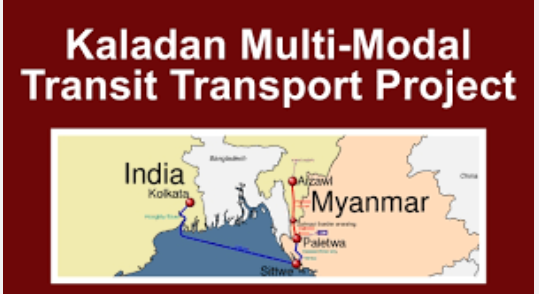Kaladan Multi-Modal Transit Transport Project
The Kaladan Multi-Modal Transit Transport Project is a collaborative venture between India and Myanmar to establish a multi-modal transport corridor connecting the eastern Indian seaport of Kolkata with Sittwe seaport in Myanmar’s Rakhine State. The project aims to create a strategic transit route between India’s landlocked northeastern states and the Bay of Bengal, bypassing the narrow Siliguri Corridor and reducing transportation costs and time.
Project Components
The Kaladan Multi-Modal Transit Transport Project consists of three main components:
- Sittwe Port Development: The project involves the construction of a deep-water port at Sittwe, located on the Bay of Bengal in Myanmar’s Rakhine State. The port will serve as the entry point for cargo shipped from Kolkata, India.
- Kaladan River Transport: The second component involves the development of an inland water transport system along the Kaladan River, which flows from Mizoram in India to Sittwe in Myanmar. This will include the dredging and widening of the river to make it navigable for cargo vessels.
- Road Construction: The final component of the project is the construction of a 109-kilometer road connecting the town of Paletwa in Myanmar to the Indo-Myanmar border in Mizoram. This road will facilitate the transport of goods from the Kaladan River to India’s northeastern states.
Significance for India
The Kaladan Multi-Modal Transit Transport Project holds immense strategic and economic significance for India, particularly for its northeastern states. Some of the key benefits include:
- Enhancing connectivity: The project will provide an alternative route for the transportation of goods to India’s northeastern states, which are currently connected to the rest of the country only through the narrow Siliguri Corridor.
- Reducing transportation costs: The multi-modal transport corridor will significantly reduce the transportation costs and time for goods shipped from Kolkata to India’s northeastern states, as compared to the current road route through the Siliguri Corridor.
- Boosting economic development: The enhanced connectivity and reduced transportation costs are expected to boost economic development in India’s northeastern states by facilitating trade and commerce.
- Strengthening bilateral ties: The project is a testament to the growing economic and strategic cooperation between India and Myanmar and is expected to strengthen bilateral ties between the two countries.
Progress and Challenges
The Kaladan Multi-Modal Transit Transport Project has made significant progress since its inception in 2008. The construction of the Sittwe Port and the dredging of the Kaladan River have been completed, and the port became operational in 2019. However, the project has also faced several challenges, including:
- Insurgency and security concerns: The project area, particularly in Myanmar’s Rakhine State, has been affected by insurgency and security issues, which have hindered the progress of the project.
- Land acquisition: The acquisition of land for the construction of the road connecting Paletwa to the Indo-Myanmar border has faced delays due to local opposition and compensation issues.
- Environmental concerns: The project has also faced criticism from environmental groups, who have raised concerns about the potential impact on the delicate ecosystem of the Kaladan River and the surrounding areas.
Future Prospects
Despite the challenges, the Kaladan Multi-Modal Transit Transport Project is expected to be completed in the near future. Once operational, the project has the potential to transform the economic landscape of India’s northeastern states and further strengthen India’s ties with Myanmar. The project is also expected to enhance India’s strategic presence in the Bay of Bengal and the Indo-Pacific region, countering China’s growing influence in the region.
The Kaladan Multi-Modal Transit Transport Project is a significant initiative undertaken by India and Myanmar to enhance regional connectivity, boost economic development, and strengthen bilateral ties. While the project has faced challenges, its successful completion is expected to bring about a transformation in the transportation and trade dynamics of the region, benefiting both India and Myanmar in the long run.


